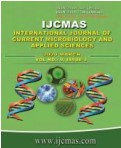


 National Academy of Agricultural Sciences (NAAS)
National Academy of Agricultural Sciences (NAAS)

|
PRINT ISSN : 2319-7692
Online ISSN : 2319-7706 Issues : 12 per year Publisher : Excellent Publishers Email : editorijcmas@gmail.com / submit@ijcmas.com Editor-in-chief: Dr.M.Prakash Index Copernicus ICV 2018: 95.39 NAAS RATING 2020: 5.38 |
Renal failure is a predominant cause of mortality in pets irrespective of the type of the feed they are fed with. The commercial protein rich diet, homemade diet and feeding methods along with many infectious diseases predispose the pets to renal related problems/disorders. The study was designed to record the incidence of kidney disorders based on the biochemical profile in the dogs that did not exhibit any clinical symptoms. Diagnosis in the earlier stages of the renal disease would aid to undertake the appropriate therapy at the earliest. Blood urea nitrogen (BUN) and creatinine are the two most commonly utilized indicators of renal damage. BUN and creatinine values begin to rise slightly with the loss of the renal function, although BUN elevation of non-renal origin occurs, values seldom exceed 50mg/dL as a result of non-renal causes. Serum phosphorus levels are often not elevated in cases of juvenile renal disease as the reduction in renal function progress slowly so that the puppy could compensates to retain normal serum phosphorus levels. After analyzing the available records it was found that about 75% of renal function would be lost even before the elevation is detectable. Although BUN and creatinine levels were often greatly elevated, serum phosphorus levels were increased in about 50% of cases only, BUN and creatinine levels were the good indicators of renal problems when compared other parameters.
 |
 |
 |
 |
 |